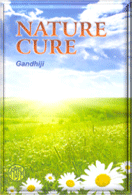
P.O. SEVAGRAM, DIST.WARDHA 442102, MS, INDIA. Phone: 91-7152-284753
FOUNDED BY MAHATMA GANDHI IN 1936
Nature Cure

NATURE CURE
Written by : M. K. Gandhi
Table of Contents
Part-I: Part-II: Nature Cure Treatment Part-III: Nature Cure Experiments- Faith on Its Trial
- Experiments in Earth and Water Treatment
- Necessity of Milk
- Treating A Fractured Arm
- Haemorrhage
- Pleurisy
- Near Death's Door
About This Book
Written by : M. K. Gandhi
Edited by : Bharatan Kumarappa
Foreword by : Morarji Desai
First Edition :10,000 copies, 1948
I.S.B.N :81-7229-071-3
Printed and Published by :Jitendra T. Desai,
Navajivan Mudranalaya,
Ahemadabad-380014
India.
© Navajivan Trust, 1960
Download
Part-II: NATURE CURE TREATMENT
Chapter-1: Earth
Just lays great
emphasis on the use of earth. For constipation, he advises cold mud
poultice on the lower abdomen. The mud poultice should be 3" broad, 6"
long and V2" thick. Just claims that mud can cure a man bitten by a
poisonous snake. He would pack wet earth all round the body. I mention
this for what it is worth. I would like to put down here what I have
tested and proved for myself. It is my experience that a mud poultice
applied to the head, relieves headache in most cases. I have tried it in
hundreds of cases. Headache may be due to several causes, but whatever
the cause, as a general rule, an application of mud poultice relieves it
for the time being.
Mud poultices cure
ordinary boils. I have applied mud to discharging abscesses as well. For
these cases I prepare the poultice by packing the mud in a clean piece
of cloth dipped in potassium permanganate lotion, and apply it to the
abscesses after washing it clean with permanganate lotion. In the
majority of cases this treatment results in complete cure. I do not
remember a single case in which it has failed me. Mud application
immediately relieves the pain of a wasp sting. I have used it in many
cases of scorpion bite, though with much less success. Scorpions have
become a nuisance in Sevagram. We have tried all the known treatments
for scorpion bite, but none has proved infallible. I can say this that
the results of mud application are not inferior to those of any other
form of treatment.
In high fever, an
application of mud poultice on the head and abdomen is very useful.
Although it does not always bring down the temperature, it does
invariably soothe the patient and make him feel better, so that the
patients themselves ask for these applications. I have used it in
several cases of typhoid fever. The-fever no doubt runs its own course
but mud applications seem to relieve restlessness and abate the
suffering. We have had about ten cases of typhoid fever in Sevagram with
complete recovery in every case, so that the inmates of the Ashram are
no longer afraid of typhoid fever. I have not used any drugs in the
treatment of these cases. I have made use of other Nature Cure methods
besides mud poultices, but about those in their own place.
In Sevagram we have
made free use of hot mud poultices as a substitute for anti-phlogistine.
A little oil and salt is added to the mud and it is heated sufficiently
long to ensure sterilization.
I have not told the
reader what kind of earth should be used for mud poultices. In the
beginning I used to procure sweet smelling clean red earth. It emits a
delicate smell when it is mixed with water. But this kind of earth is
not easy to obtain. In a city like Bombay it is a problem to get any
kind of earth. It is safe to use soft alluvial clay, which is neither
gritty nor sticky. One should never use earth taken from manured soil.
Earth should be dried, pounded, and passed through a fine sieve. If
there is any doubt as to its cleanliness, it should be well heated and
thus sterilized. Mud used as a poultice on a clean surface need not be
thrown away after use. It can be used again and again after drying it in
the sun or on fire and pounding and sieving it. I am not aware that mud
poultice made out of the same earth again and again as described above,
is any the less efficacious. I have myself used it in this way and did
not find it any the less efficacious for repeated use. Some friends who
regularly use mud poultices, tell me that mud from Yamuna's banks is
particularly good for this purpose.
Just writes that clean
earth may be eaten in order to overcome constipation. Five to ten grams
is the maximum dose. The rationale is said to be this. Earth is not
digested. It acts as roughage and must pass out. The peristalsis thus
stimulated pushes out the faecal matter as well. I have not tried it
myself. Therefore those who wish to do so, should try on their own
responsibility. I am inclined to think that a trial or two is not likely
to harm anyone.
Key to Health, pp. 58 to 62